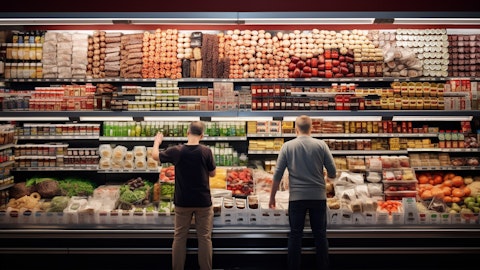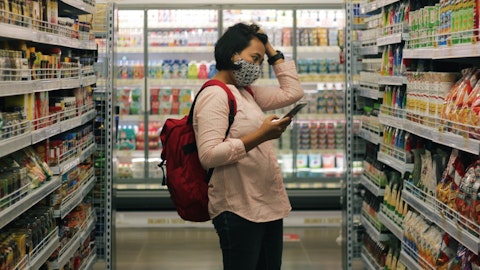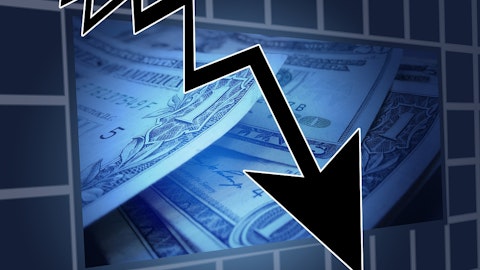Jeff Harmening: Yeah. Andrew, I’m glad you asked, and I appreciate the fact you’re getting a lot. I think, it’s a really important question, because our job is to maximize long term shareholder return, not any particular quarter, frankly, even any particular year. And so, one of the things that we — as we look back over time when the consumer is stressed and the results are harder to come by, one of the things we’ve seen successful companies like ours do is reinvest for the future. And that comes in the form of consumer investment, but also investment in capabilities, things like strategic revenue management and performance marketing and automating supply chains and things like that. And so incumbent and included in our results is an increase in consumer spending, even though we’ve guided down on our sales for the year, we’ll still invest in consumer spending and we’re still investing in all of the capabilities that we know will drive our growth, not only for this year but in years to come.
And then that’s with regard to growing revenues, but also maintaining our discipline on HMM and automation and using AI in our supply chains are going to be important parts of that as well. So, one of the things I want to make sure you can tell your investors is that, while our profit guidance is still 4% to 5% growth on EPS, that’s inclusive of making sure we maintain our reinvestment in the business. And we’re able to do that, because our HMM levels are very high right now. We’re taking out the cost from our supply chain. And as you mentioned, our admin costs are declining.
Andrew Lazar: Great. Thanks for that. And then just on — a bit more on the faster competitor normalization of shelf availability comments that you made in the prepared remarks. Is it an issue in a specific category or is it more broad based? And is it General Mills actually losing shelf space, or really just others now having better availability in the slots that they have? And what have you seen that mean for promotional intensity or not? Thanks so much.
Jeff Harmening: All right. Andrew, I’m going to try to address all those questions and if I miss one, come back, because I didn’t mean to…
Andrew Lazar: Will do.
Jeff Harmening: Because I didn’t mean to skip.
Andrew Lazar: Will do.
Jeff Harmening: On the on-shelf availability, when we put our guidance together for this year, I mean, we grew at 10% last year and original guidance was 3% to 4% this year. And so we knew that on-shelf availability would be a headwind for us, because frankly our supply chain held up a lot better than our competition did a year ago. And so, we calculate, we factored that into our guidance for this year. But the fact of the matter is, on-shelf availability for our competition increased a lot faster, particularly private label and small players, faster than we had anticipated. Importantly, they’re now catching up to our on-shelf availability. And so, we’ve actually improved our on-shelf availability this year. So, it’s not as if we have gone backward.
We are — our on-shelf availability is higher now and you can see that out, because we’ve reduced our disruption cost. It’s just that our competitors have increased quite a bit now, have kind of drawn even with us after trailing for like four years. So that’s the first part of the question. We anticipated it, but not the rate of change. In terms of the — and we’ll lap — we’ll start lapping that really in kind of late April and May of this year. So, that’s when we started to see this impact. In terms of distribution, one of the things — our teams across the board, certainly in North America Retail are really executing well. Our share of distribution is actually up, and so there’s not a problem with our distribution. In fact, the opposite.
Our distribution looks good. And I will say that I’m really excited about our innovation in the back half of this year, which I’m hoping will bolster that further. We’ve got good innovation in cereal. We’ve got good innovation in yogurt and soup and Old El Paso and Haagen-Dazs. And so, as I look across our big billion dollar businesses, our innovation lineup is really good and, frankly, better than it was last year. And so, as we look to the next half of the year, I think, we can see our distribution continuing to build. As to what it means to promotional, the promotional environment, it’s been a very rational promotional environment against some thoughts to the contrary. We have seen the number of promotions pick up this year, as we expected, because of on-shelf availability.
Importantly, we’ve also seen the quality of the merchandising, specifically the quality of merchandising that we get, has also accelerated. And because the quality of merchandising has improved for us, we’ve seen the lists we receive, but also the ROIs we receive have been better than they were a year ago. But importantly, and this is a really important point, even though the level of merchandising has increased in frequency, it has not increased in depth. And even the frequency is still below where it was before the pandemic, and the depth of the promotion is well below. So, yes, we’re seeing increased levels of promotion. We expected that. And, frankly, the returns are better, because of the quality of merchandising that we’re seeing.




